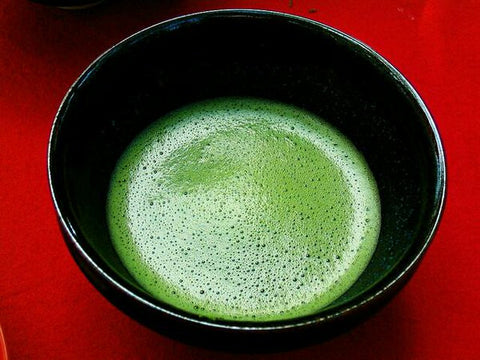A Japanese tea ceremony is not a tea party. It is a solemn and profound affair intended to help the participants appreciate the tranquility of life, the distinctiveness of each moment, and seek enlightenment and inner peace in this chaotic world.
Governed by a concept called Ichigo Ichie which translates to “one meeting”, the tea ceremony is about creating an awareness of the fact that every moment that the guests and the host spend together is one-of-a-kind and cannot come back again in their lives.
Matcha tea is at the heart of the ceremony, and it is believed to hold many keys to the mysteries of this centuries-old Japanese tradition.
There are so many variations of the dōgu that just the names of them could fill a several-hundred-page book. So, for simplicity, here’s a list of the most important tools:

The key component of the Japanese tea ceremony is Matcha tea. Only the finest ceremonial grade Matcha is used in the tea ceremony, so, be careful to choose only the finest.

This may seem obvious, but the vessel from which you drink Matcha is key to the entire experience of the ceremony. The Chawan or bowl in which the tea is served needs to be chosen based on the season. For instance, shallow bowls are used in summer to cool down the tea quick.
The scoop or Chashaku is made from bamboo. Used for measuring and scooping Matcha out from tea containers into the Chawan, the Chashaku is a long spoon which originally came to Japan from China. In those early days, it used to be made of ivory or tortoiseshell. Like many other Japanese objects, Chashaku is also categorized into three degrees of formality such as: Formal (Shin), Semi-formal (Gyo) and Informal (So).
The bamboo Chashaku is said to have been created by the greatest tea master of all time, Sen no Rikyu.

The Chasen is a whisking tool that is used for mixing Matcha with hot water. As with all the other tools of the tea ceremony, the whisk also has different variations. It is said that there are around 100 types of Chasen available, made from a variety of materials, usually by highly skilled craftsmen.
The variations usually are in the colour of the bamboo, number of tines, length of the whisk and the colour of the string.
In Japanese, a teapot is called Kama. Typically made of iron, it keeps the water for the tea boiling hot. Just like the rest of the tools, the teapot also comes in several varieties of style. It is usually passed down from one generation to the next.
A soft, silken cloth, known as Fukusa is used in the Japanese tea ceremony. It’s a square piece of silk which is used for cleaning the tea utensils before and after the ceremony. Usually available in solid colour, the Fukusa has code of colour to be maintained. Men are supposed to use purple cloth whereas women are to use orange or red coloured ones. White cloth can also be used.
A tea ceremony enthusiast will have all these tools and more in their possession to hold Chado and to teach others who might be interested in the way of tea.

There are many lines crisscrossing a tearoom. Some are real, some imaginary. The purpose of these is to determine the correct placement of the tools and numerous other details.
When you are hosting a Japanese tea ceremony at home, you should be careful to remember all of these details to make the ceremony perfect.
Have a wonderful tea ceremony!Comments will be approved before showing up.